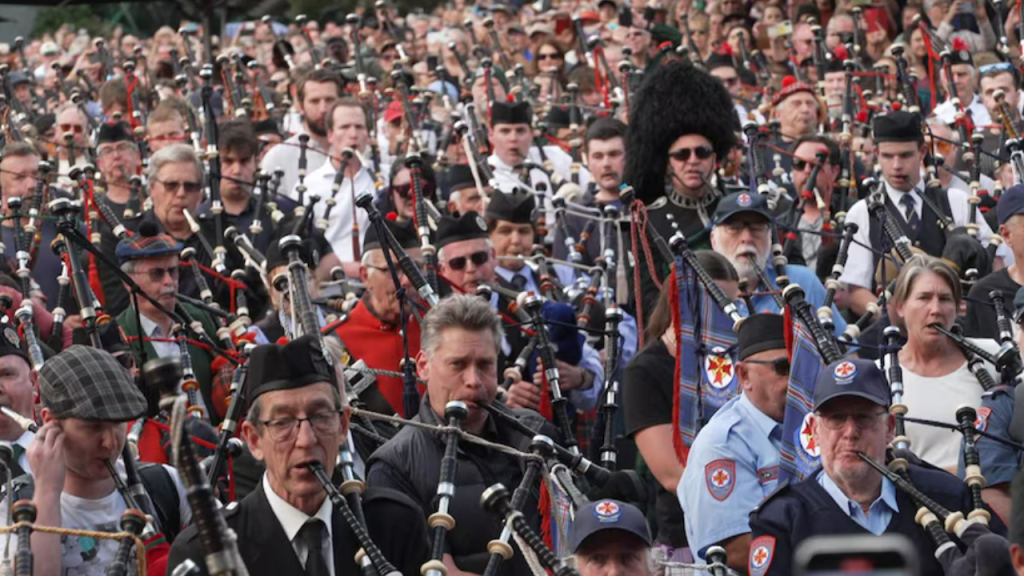Melbourne has always had a flair for surprise, but yesterday the city outdid even its own reputation for spontaneous cultural spectacle. It began as a rumor drifting through the CBD: hundreds of bagpipers were assembling in the central plaza. By midday, the rumor became a thunderous reality. A staggering 374 pipers filled the square, shoulder to shoulder, drones lifted skyward, chanters gripped and ready. Their mission was as bold as it was joyful — to perform AC/DC’s “It’s a Long Way to the Top (If You Wanna Rock ’n’ Roll)” in unison, and in doing so, set a new world record for the largest bagpipe ensemble ever assembled.
The sound, when it arrived, was not subtle. It swept across the city like a sonic tide, echoing between office towers, rattling the outdoor café umbrellas, and momentarily replacing the familiar ding of trams with the unmistakable wail of hundreds of pipes locked on a single anthem. Melbourne has long prided itself on being Australia’s cultural heartbeat, but even seasoned locals were left wide-eyed at the scale of what they were hearing.
This wasn’t a quirky stunt or a niche musical gathering. It was a full-blown civic event — a convergence of musicians, rock fans, families, school bands, pipe majors, tourists, and office workers who found themselves stumbling into a moment that felt instantly legendary.
The plaza itself became a tapestry of tartans. Greens, blues, reds, blacks, and every pattern in between layered across the square in a patchwork of Scottish and Celtic heritage. Some pipers wore full formal Highland dress; others arrived in band jackets, kilts paired with sneakers, or relaxed interpretations of traditional gear. Yet the visual diversity only heightened the sense of unity. At a glance, you could see traditions, ages, and communities — school ensembles playing beside lifelong pipers, hobbyists beside national-level competitors — converging for a single purpose.
The choice of song was no accident. AC/DC’s “It’s a Long Way to the Top” is one of the few mainstream rock tracks that leans unapologetically into bagpipe bravado. Bon Scott’s bagpipe feature remains one of the most unconventional and beloved flourishes in the rock canon. A converge of electric swagger and Celtic fire, the track became a kind of national anthem for Australian irreverence — ambitious, loud, and unbothered by purity of genre. To play it with 374 pipers wasn’t merely fitting; it felt inevitable.
When the conductor’s arms lifted, a silence fell over the plaza. A silence so uncanny, considering the number of instruments poised to break it, that even the crowd seemed to hold its breath. And then it hit — a synchronized opening burst that rolled across the plaza like the opening shot of a stadium concert, only multiplied by hundreds of drones and harmonics. The arrangement had been rehearsed, refined, and simplified just enough to allow such a massive ensemble to execute it cleanly. The result was breathtaking: a colossal wall of sound that managed to be both chaotic and beautifully cohesive.
Video clips captured the moment almost immediately — panoramic sweeps showing the entire plaza vibrating with sound, close-ups of pipers playing through grins, tears, and occasionally the physical strain of powering a notoriously demanding instrument. Even for musicians used to playing in large pipe bands, this was something else entirely. The emotional weight of performing an Australian rock classic — and doing so as part of the largest group of pipers ever recorded — was palpable.
The audience’s reaction mirrored the scale of the performance. Some laughed in disbelief, hands over their mouths at the sheer magnitude of the noise. Others swayed, eyes closed, letting the sound wash over them. Children clapped rhythmically. Elderly fans leaned on canes, savoring a moment that collapsed decades of musical history into a single afternoon. It was not just a performance to witness; it was a performance to feel. And Melbourne felt every note.
The world-record attempt was executed with meticulous care. Each piper had been counted, registered, and positioned according to strict guidelines. Verifiers from the record-keeping organization moved through the crowd with clipboards and counters. Even the warm-ups were impressive — hundreds of pipes tuning and droning in scattered clusters around the plaza, creating an uncanny, swirling pre-show ambiance.
When the final tally was confirmed — 374 pipers — the plaza erupted again, this time not in sound but in collective triumph. Musicians hugged one another. Audience members cheered as if Melbourne had just won a championship title. The pipers took photos, raised instruments triumphantly, and basked in the knowledge that they had just made musical history. The record wasn’t just broken; it was redefined.
Beyond the spectacle, the event highlighted Melbourne’s deep-rooted relationship with community music. Bagpipe culture thrives here more than many realize. School pipe bands, multicultural festivals, regional Highland gatherings, and long-standing family traditions keep the instrument alive in a way few cities outside Scotland can claim. But rarely do these threads come together in a single, unified display. Yesterday, they did — and the result was overwhelming.
There is a particular magic in large-scale musical gatherings, especially those powered by volunteer enthusiasm rather than commercial machinery. They remind us of what cities can be: spaces not only for movement and work but for collective, joyful interruption. Music at this scale transforms public space into something temporary and ephemeral, yet unforgettable. For a few hours, Melbourne’s central plaza wasn’t just a meeting point; it was a resonant chamber that held the power of hundreds of lungs, reeds, and memories.
As the last chords faded and the pipers began to disperse, the afterglow lingered. Locals lingered long after the performance ended, conversations buzzing with versions of “Did you see that?” and “I’ve never heard anything like it.” Clips spread across social media in real time, quickly attracting millions of views across TikTok, Instagram, YouTube, and X. AC/DC fans worldwide reacted with shock, delight, and, in some cases, envy that they hadn’t witnessed the moment in person. Bagpipe forums lit up with pride and disbelief. Cultural commentators noted that only Melbourne could deliver something so grand, so strange, and so utterly unselfconscious.
But more profound than the record itself was the feeling the event created: that in a world often fractured by noise of a different kind, a city could still come together and make a joyful one. A loud one. A historic one. A moment of shared humanity wrapped in tartan and driven by the rebellious pulse of rock ’n’ roll.
No comments yet.








